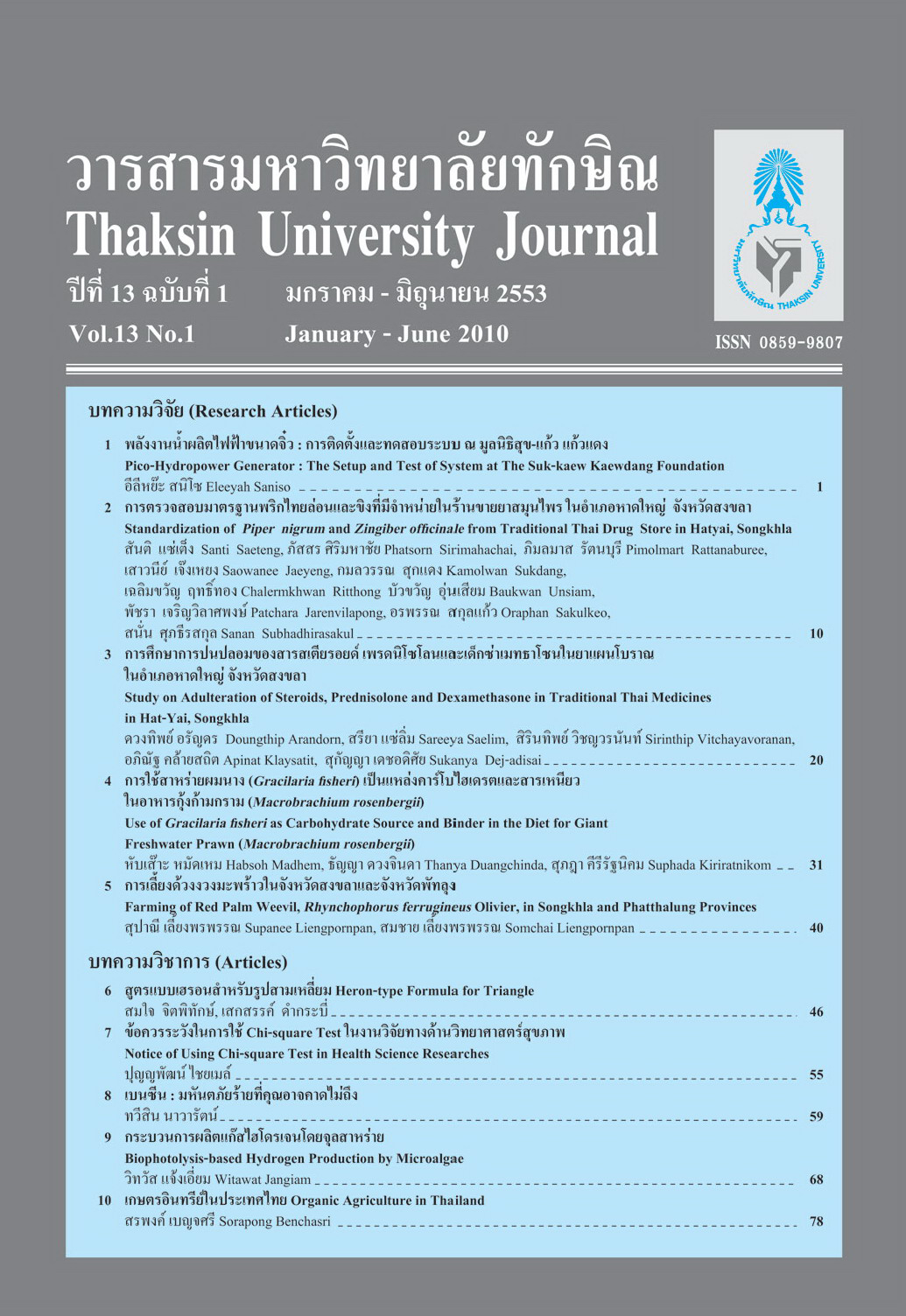การใช้สาหร่ายผมนาง (Gracilaria fisheri) เป็นแหล่งคาร์โบไฮเดรตและสารเหนียว ในอาหารกุ้งก้ามกราม (Macrobrachium rosenbergii)
Main Article Content
Abstract
ศึกษาอัตราการเจริญเติบโต อัตราการแลกเนื้อ อัตรารอด และองค์ประกอบทางเคมีของกุ้งก้ามกรามที่ได้รับอาหาร 5 สูตร ได้แก่อาหารที่ไม่มีส่วนผสมของสาหร่ายผมนาง (สูตรควบคุม) และอาหารทดลองที่มีส่วนผสมของสาหร่ายผมนาง เป็นแหล่งคาร์โบไฮเดรตและสารเหนียวในปริมาณ 5, 10, 15 และ 20 เปอร์เซ็นต์ โดยใช้เวลา 8 สัปดาห์ พบว่าเมื่อสิ้นสุด การทดลองกุ้งก้ามกรามชุดควบคุมและชุดที่เลี้ยงด้วยอาหารผสมสาหร่ายผมนาง 5 เปอร์เซ็นต์ มีน้ำหนักเฉลี่ยไม่แตกต่าง กัน แต่มีค่าสูงกว่ากุ้งที่เลี้ยงด้วยอาหารผสมสาหร่ายผมนาง 15 และ 20 เปอร์เซ็นต์อย่างมีนัยสำคัญ (P<0.05) ส่วนกุ้ง ก้ามกรามที่เลี้ยงด้วยอาหารผสมสาหร่ายผมนาง 10 เปอร์เซ็นต์มีแนวโน้มเป็นไปได้ทั้งสองทางกล่าวคือไม่มีความแตกต่าง จากกุ้งชุดควบคุมและกุ้งที่เลี้ยงด้วยอาหารผสมสาหร่ายผมนางทุกสูตร ผลการทดลองในทำนองเดียวกันนี้ยังปรากฏในแง่ ของอัตราการเจริญเติบโตจำเพาะ อัตราการเจริญเติบโตต่อวัน และ อัตราการแลกเนื้อของกุ้งมี ส่วนอัตรารอดของ กุ้งก้ามกรามทุกชุดการทดลองอยู่ในช่วง 50 – 76 เปอร์เซ็นต์ซึ่งไม่แตกต่างกันทางสถิติ (P>0.05) สำหรับองค์ประกอบทาง เคมีของกุ้งก้ามกรามเมื่อสิ้นสุดการทดลองพบว่า ปริมาณคาร์โบไฮเดรตและโปรตีนของกุ้งก้ามกรามที่เลี้ยงด้วยอาหาร ทดลองชุดควบคุมและอาหารที่ผสมสาหร่ายผมนาง 5, 10 และ 15 เปอร์เซ็นต์ มีค่าไม่แตกต่างกัน ส่วนไขมันของกุ้งชุด ควบคุมมีค่าสูงที่สุดแต่มีค่าใกล้เคียงกันกับกุ้งที่เลี้ยงด้วยอาหารผสมสาหร่ายผมนาง จากการทดลองครั้งนี้สรุปได้ว่า สามารถใช้สาหร่ายผมนางเป็นแหล่งคาร์โบไฮเดรตและสารเหนียวในอาหารกุ้งก้ามกรามได้ 0 – 15 เปอร์เซ็นต์ โดยไม่มี ผลต่อการเจริญเติบโต อัตราการแลกเนื้อ อัตรารอด รวมทั้งองค์ประกอบทางเคมีของกุ้งก้ามกราม
The aim of this study was to determine about growth, food conversion ratio, survival and chemical composition of the giant freshwater prawn (Macrobrachium rosenbergii) fed with 5 diets. These were the control diet that Gracilaria fisheri (red algae) was not added and the diets that carbohydrate and binder were replaced by G. fisheri by 5, 10, 15 and 20 percent. The experimental period was 8 weeks. At the end of the experiment, there was no significant difference between the average body weight of the giant freshwater prawn fed the control diet and the diet that 5 percent of G. fisheri was added. However, these were higher than the prawn fed the diets that 15 and 20 percent of G. fisheri were added (p < 0.05). In addition, there was no significant difference between the prawn fed the diet that 10 percent of G. fisheri was added, and the prawn from other trails. The similar results were also happened in terms of specific growth rate, daily weight gain and food conversion ratio. However there was 50 to 76 % survival rates were found in all trials without any differences (P > 0.05). According to proximate analysis, it was found that carbohydrate and Protein of the prawn fed the control diet and the diet that 5, 10 and 15 percent of G. fieheri was added were also not significantly difference. However, the lipid concentration of the prawn without the additional of G. fieheri was highest, but adjacent to the lipid concentrations of the prawn from other trials. In conclusions, 0-15 % of red algae (Gracilaria fisheri) could replace carbohydrate and binder in the diet for giant freshwater prawn (Macrobrachium rosenbergii) without any impact on growth, food conversion ratio, survival as well as chemical composition of the prawn.


